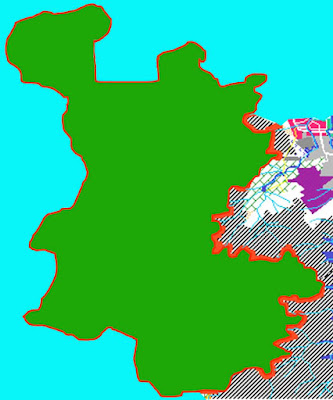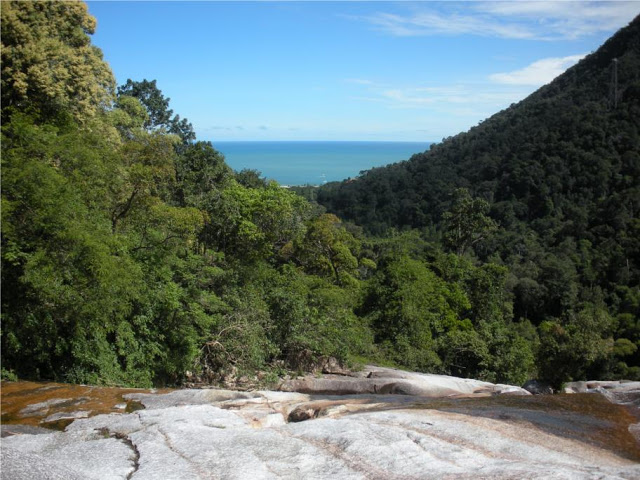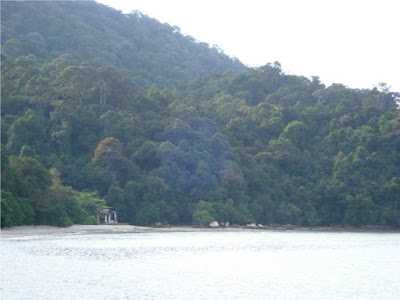 |
| From Penang Hotels Review |

Main Entrance To The Park
Pulau Pinang National Park | Location
Pulau Pinang National Park is located at the northwest corner of Penang Island overlooking the Straits of Malacca. The park is about 400 km from Kuala Lumpur and about 30 km (45 minutes) from Georgetown, Penang.
The park caters for day use visitors only. There will be no accommodation and campsite for tourist so as to minimize human impacts on the park.
Overnight camping is offered only through organized nature camp / conservation education programs by the Park Service for schools, colleges and higher learning institutions.
Visitors / tourists should stay at the numerous hotels available at Batu Ferringhi and Telok Bahang, a well-established tourism area.
These areas are well supported with food outlets, convenient stores, souvenir shops, entertainments, clinics and other tourist services.
Pulau Pinang National Park | Attractions
Pulau Pinang National Park, a natural forest sprawl at Penang Island’s northwestern most tip, is called “Bay of Glowing Embers” due to its scenic and spectacular sunset.
The natural attractions of Pulau Pinang National Park include the Hill / Lowland Dipterocarp Forests, Mangrove Forest areas, Sandy Beach habitats, the unique seasonal meromictic lake and the open coastal seas.
Stands of Seraya (Shorea curtisii) trees, common feature of coastal Dipterocarp Forest, can be easily seen on steep slopes around Muka Head.
There are over 1000 species of plants recorded which are dominated by the family Dipterocarpaceae, Leguminoceae, Apocynaceae, Anacardiaceae, Euphorbiaceae and Moraceae.
The historical Muka Head Lighthouse is sited on a granite peak with steep slopes and rocky cliffs fronting the coastline of the Straits of Malacca.
Built in 1883, this vintage lighthouse is a historical site to visit by following a steep jungle trail at Muka Head.
There are abundant wildlife species that take up residence in various habitats of Muka Head. A total of 190 species of fauna recorded which include 28 mammal, 14 reptile, 148 bird species and other reptiles, insects and amphibians.
Common animals include monkeys, otters, mousedeer, wild boar, flying lemur, squirrels, monitor lizards, turtles and pythons.
The white-belied sea eagle and their nests on tree canopies can be easily observed at coastal forests.
Two species of turtles, notably the green (Chelonia mydas) and olive-ridley (Lepidochelys olivacea) turtles, frequent the west facing beaches to nest from April to August and between September and February respectively to nest, especially at Pantai Kerachut.
The Irrawaddy dolphins are sometime seen in coastal seas of this park. Migratory birds are abundant during migration from October to January.
The small time local fishermen are the main user and beneficiaries of this park, where fishing activities are limited by using hook and line, small nets, fish traps and aquaculture fish cages on pontoons.
Their activities are a sight to see especially in the evening before sunset.
Pulau Pinang National Park | Ecotourism as an effective conservation tool
Tourism in protected areas is becoming an important component of our government policy since it has tremendous potential as a tool to conserve natural and cultural heritage of Malaysia.
While protecting the biodiversity and environment, the park will practice sustainable management of ecotourism. This is to ensure the conservation of the park’s biodiversity resources on which ecotourism activities depend so as to be sustainable in the long term.
Among others, this means that the park’s resources is regulated and not overuse, the natural environment of the park and adjacent / surrounding human environment protected, and the local community involved and benefited from this nature-based ecotourism activities at Pulau Pinang National Park and its vicinity.
Pulau Pinang National Park | Park’s Area Description
It is a metropolitan national park of 1,213 hectares and consists of pristine coastal-forested area harbouring a wealth of flora and fauna.
It remains a sanctuary for nature within a hilly and forested part of Penang Island.
Among its unique assets are 5 habitat types not found in other major nature reserves in Malaysia, the only confirmed meromictic lake in Peninsular Malaysia, wetlands, mangroves, mudflats, coral reefs, and turtle nesting beaches.
Pulau Pinang National Park | Access and Circulation
Entrance to the park is through Telok Bahang, located at the end of the Batu Ferringhi Road. The park is accessible through a walking trail or by boat from Telok Bahang fishing village’s jetty.
View Penang National Park in a larger map
Pulau Pinang National Park | Gallery
Penang National Park | Rest Place
Penang National Park
Penang National Park | Bridge
Penang National Park | Walkway
Penang National Park | Sea Eagle
Penang National Park | RainForest
Penang National Park | Ferns
Penang National Park | Telok Bahang Fishermen Jetty
Pulau Pinang National Park is located at the northwest corner of Penang Island overlooking the Straits of Malacca. The park is about 400 km from Kuala Lumpur and about 30 km (45 minutes) from Georgetown, Penang.
 |
| From Penang Hotels Review |
Pulau Pinang National Park | Accommodation
The park caters for day use visitors only. There will be no accommodation and campsite for tourist so as to minimize human impacts on the park.
Overnight camping is offered only through organized nature camp / conservation education programs by the Park Service for schools, colleges and higher learning institutions.
Visitors / tourists should stay at the numerous hotels available at Batu Ferringhi and Telok Bahang, a well-established tourism area.
These areas are well supported with food outlets, convenient stores, souvenir shops, entertainments, clinics and other tourist services.
Pulau Pinang National Park | Attractions
Pulau Pinang National Park, a natural forest sprawl at Penang Island’s northwestern most tip, is called “Bay of Glowing Embers” due to its scenic and spectacular sunset.
The natural attractions of Pulau Pinang National Park include the Hill / Lowland Dipterocarp Forests, Mangrove Forest areas, Sandy Beach habitats, the unique seasonal meromictic lake and the open coastal seas.
Stands of Seraya (Shorea curtisii) trees, common feature of coastal Dipterocarp Forest, can be easily seen on steep slopes around Muka Head.
There are over 1000 species of plants recorded which are dominated by the family Dipterocarpaceae, Leguminoceae, Apocynaceae, Anacardiaceae, Euphorbiaceae and Moraceae.
The historical Muka Head Lighthouse is sited on a granite peak with steep slopes and rocky cliffs fronting the coastline of the Straits of Malacca.
Built in 1883, this vintage lighthouse is a historical site to visit by following a steep jungle trail at Muka Head.
There are abundant wildlife species that take up residence in various habitats of Muka Head. A total of 190 species of fauna recorded which include 28 mammal, 14 reptile, 148 bird species and other reptiles, insects and amphibians.
Common animals include monkeys, otters, mousedeer, wild boar, flying lemur, squirrels, monitor lizards, turtles and pythons.
The white-belied sea eagle and their nests on tree canopies can be easily observed at coastal forests.
Two species of turtles, notably the green (Chelonia mydas) and olive-ridley (Lepidochelys olivacea) turtles, frequent the west facing beaches to nest from April to August and between September and February respectively to nest, especially at Pantai Kerachut.
The Irrawaddy dolphins are sometime seen in coastal seas of this park. Migratory birds are abundant during migration from October to January.
The small time local fishermen are the main user and beneficiaries of this park, where fishing activities are limited by using hook and line, small nets, fish traps and aquaculture fish cages on pontoons.
Their activities are a sight to see especially in the evening before sunset.
Pulau Pinang National Park | Ecotourism as an effective conservation tool
Tourism in protected areas is becoming an important component of our government policy since it has tremendous potential as a tool to conserve natural and cultural heritage of Malaysia.
While protecting the biodiversity and environment, the park will practice sustainable management of ecotourism. This is to ensure the conservation of the park’s biodiversity resources on which ecotourism activities depend so as to be sustainable in the long term.
Among others, this means that the park’s resources is regulated and not overuse, the natural environment of the park and adjacent / surrounding human environment protected, and the local community involved and benefited from this nature-based ecotourism activities at Pulau Pinang National Park and its vicinity.
Pulau Pinang National Park | Park’s Area Description
It is a metropolitan national park of 1,213 hectares and consists of pristine coastal-forested area harbouring a wealth of flora and fauna.
It remains a sanctuary for nature within a hilly and forested part of Penang Island.
Among its unique assets are 5 habitat types not found in other major nature reserves in Malaysia, the only confirmed meromictic lake in Peninsular Malaysia, wetlands, mangroves, mudflats, coral reefs, and turtle nesting beaches.
Pulau Pinang National Park | Access and Circulation
Entrance to the park is through Telok Bahang, located at the end of the Batu Ferringhi Road. The park is accessible through a walking trail or by boat from Telok Bahang fishing village’s jetty.
The park is well link by a network of forest trails from the entry point at Telok Bahang to development areas at Sungai Tukun, Telok Aling, Muka Head Lighthouse and Pantai Kerachut.
A nature trail also looped around the unique meromictic lake at Pantai Kerachut.
There are jetties at Telok Aling and Pantai Kerachut for visitors that enter the park by boat.
Pulau Pinang National Park | Contact Details & Address
Taman Negara Pulau Pinang
Jalan Hassan Abas,Teluk Bahang,
11050 Pulau Pinang
Pulau Pinang
Tel: (604) 881 3530/ 04-881 3500
Faks: (604) 881 2016
E-mel: tnpp@streamyx.com
http://www.wildlife.gov.my
A nature trail also looped around the unique meromictic lake at Pantai Kerachut.
There are jetties at Telok Aling and Pantai Kerachut for visitors that enter the park by boat.
Pulau Pinang National Park | Contact Details & Address
Taman Negara Pulau Pinang
Jalan Hassan Abas,Teluk Bahang,
11050 Pulau Pinang
Pulau Pinang
Tel: (604) 881 3530/ 04-881 3500
Faks: (604) 881 2016
E-mel: tnpp@streamyx.com
http://www.wildlife.gov.my
Pulau Pinang National Park | Map
View Penang National Park in a larger map
 |
| From Penang Hotels Review |
 |
| From Penang Hotels Review |
 |
| From Penang Hotels Review |
 |
| From Penang Hotels Review |
 |
| From Penang Hotels Review |
 |
| From Penang Hotels Review |
 |
| From Penang Hotels Review |
Penang National Park | Ferns
 |
| From Penang Hotels Review |
 |
| From Penang Hotels Review |
 |
| From Penang Hotels Review |
 |
| From Penang Hotels Review |
Penang National Park
 |
| From Penang Hotels Review |
 |
| From Penang Hotels Review |
Penang National Park | Sea Eagle





No comments:
Post a Comment